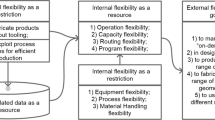Abstract
Products can consist of many sub-assemblies and small disturbances in the process can lead to larger negative effects downstream. Such variances in production are a challenge from a quality control and operational risk management perspective but also it distorts the assurance processes from an auditing perspective. To control production effectively waste needs to be taken into account in normative models, but this is complicated by cumulative effects. We developed an analytical normative model based on the bill of material, that derives the rejection rates from the underlying processes without direct measurement. The model enables improved analysis and prediction. If the rejection rate is not taken into account the function of the bill of material as a reference model deteriorates and therefore output measures become more opaque and harder to verify. As a consequence it is extremely difficult or even impossible to assess efficiency and effectiveness of operations. Secondly it is impossible to judge whether net salable assets represent the correct amount and finally it is impossible to assert whether the operations do comply to company standards and applicable laws.
Access this chapter
Tax calculation will be finalised at checkout
Purchases are for personal use only
Similar content being viewed by others
References
Baumol, W.J., Wolff, E.N.: A key role for input-output analysis in policy design. Reg. Sci. Urban Econ. 24(1), 93–113 (1994)
Boritz, J.E.: Is practitioners’ views on core concepts of information integrity. Int. J. Account. Inf. Syst. 6(4), 260–279 (2005)
Christiaanse, R., Griffioen, P., Hulstijn, J.: Adaptive normative modelling: a case study in the public-transport domain. In: Janssen, M., Mäntymäki, M., Hidders, J., Klievink, B., Lamersdorf, W., van Loenen, B., Zuiderwijk, A. (eds.) I3E 2015. LNCS, vol. 9373, pp. 423–434. Springer, Cham (2015). https://doi.org/10.1007/978-3-319-25013-7_34
Christiaanse, R., Griffioen, P., Hulstijn, J.: Reliability of electronic evidence: an application for model-based auditing. In: Proceedings of 15th International Conference on Artificial Intelligence and Law, ICAIL 2015, pp. 43–52. ACM, New York (2015)
COSO: Internal control - integrated framework. Report, Committee of Sponsoring Organizations of the Treadway Commission (1992)
COSO: Enterprise risk management - integrated framework. Report, Committee of Sponsoring Organizations of the Treadway Commission (2004)
COSO: Guidance on monitoring internal control systems. Report, Committee of Sponsoring Organizations of the Treadway Commission, USA (2009)
Davis, J., Edgar, T., Porter, J., Bernaden, J., Sarli, M.: Smart manufacturing, manufacturing intelligence and demand-dynamic performance. Comput. Chem. Eng. 47(20), 145–156 (2012)
Elmaghraby, S.E.: A note on the ‘explosion’ and ‘netting’ problems in the planning of materials requirements. Oper. Res. 11(4), 530–535 (1963)
Engell, S.: Feedback control for optimal process operation. J. Process Control 17, 203–219 (2007)
Jacobs, F.R., Weston Jr., F.C.: Enterprise resource planning (ERP)-a brief history. J. Oper. Manag. 25, 357–363 (2007)
Leontief, W.: Environmental repercussions and the economic structure: an input-output approach. Rev. Econ. Stat. 52(3), 262–271 (1970)
Liu, C.-M., Chen, L.S., Romanowski, R.M.: An electronic material flow control system for improving production efficiency in integrated-circuit assembly industry. Int. J. Adv. Manuf. Technol. 42, 348–362 (2009)
Merchant, K.A.: Modern Management Control Systems, Text and Cases. Prentice Hall, Upper Saddle River (1998)
Merchant, K.A.: The control function of management. Sloan Manag. Rev. 23(Summer), 43–55 (1982)
Moffitt, K.C., Vasarhelyi, M.A.: Accounting information systems in an age of big data. J. Inf. Syst. 27(2), 1–19 (2013)
Rachuri, S.: Smart manufacturing systems design and analysis. Report, National Institute of Standards and Technology (NIST) (2014)
Simons, R.: Levers of Control: How Managers Use Innovative Control Systems to Drive Strategic Renewal. Harvard Business School Press, Boston (1995)
Starreveld, R.W., de Mare, H.B., Joëls, E.J.: Bestuurlijke informatieverzorging, volume deel 1: Algemene grondslagen, 2nd edn. Samson Uitgeverij, Aplhen aan den Rijn/Brussel (1988). (in Dutch)
Strang, G.: Linear Algebra and its Applications. Brooks Cole, Belmont (1988)
Strong, D.M., Lee, Y.W., Wang, R.Y.: Data quality in context. Commun. ACM 40(5), 103–110 (1997)
Weigand, H., Elsas, P.: Model-based auditing using REA. Int. J. Account. Inf. Syst. 13(3), 287–310 (2012). 2011 Research Symposium on Information Integrity & Information Systems Assurance
Acknowledgement
The research in this paper was supported by the SATIN research project, funded by NWO.
Author information
Authors and Affiliations
Corresponding author
Editor information
Editors and Affiliations
Rights and permissions
Copyright information
© 2018 Springer International Publishing AG
About this paper
Cite this paper
Griffioen, P., Christiaanse, R., Hulstijn, J. (2018). Controlling Production Variances in Complex Business Processes. In: Cerone, A., Roveri, M. (eds) Software Engineering and Formal Methods. SEFM 2017. Lecture Notes in Computer Science(), vol 10729. Springer, Cham. https://doi.org/10.1007/978-3-319-74781-1_6
Download citation
DOI: https://doi.org/10.1007/978-3-319-74781-1_6
Published:
Publisher Name: Springer, Cham
Print ISBN: 978-3-319-74780-4
Online ISBN: 978-3-319-74781-1
eBook Packages: Computer ScienceComputer Science (R0)





